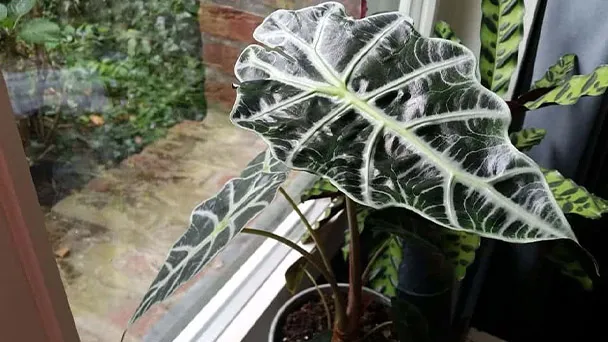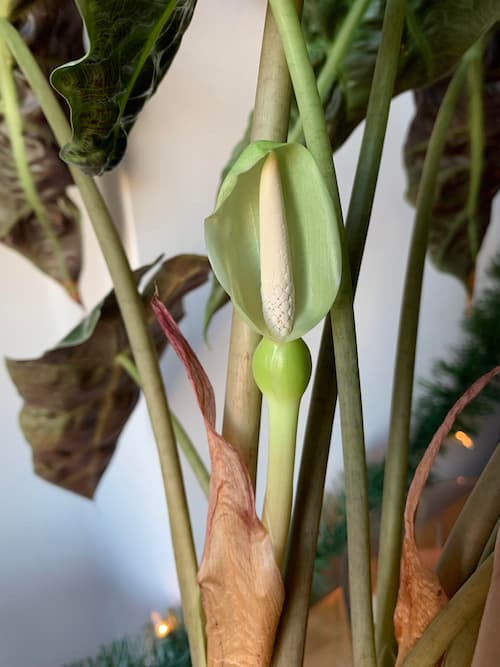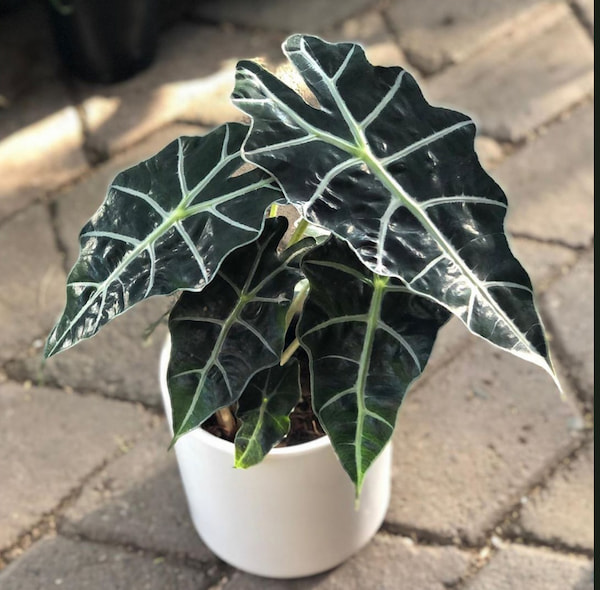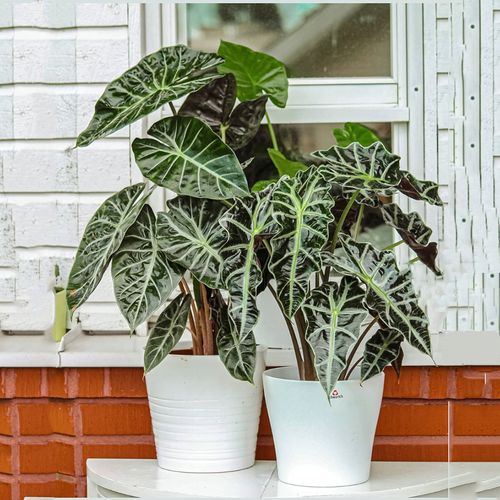Alocasia Polly Plant Profile: Care & Propagation Guide
Written by lisa
Dec 23 2021

The Alocasia Polly, also known as The Alocasia x Amazonica and African Mask Plant, is a foliage plant native to the Philippines. The perennial herb Alocasia Polly is suitable as a houseplant. First of all, The shape of the Alocasia Polly is beautiful and generous. Its leaves are very wide, and the color is bright green, which is of high ornamental value. Also, the Alocasia Polly flowers are fresh and beautiful white. The following will talk about Alocasia Polly basic information, care, propagation and common problems when growing Alocasia Polly in detail. Let’s grow this beautiful plant better after reading this article!
The flower language of alocasia polly flower has a sincere, simple meaning. The Alocasia Polly flowers are pure white, relatively simple. Though it is not so beautiful, it is active to show what it is, which makes it the flower meaning. (Read more about Alocasia Polly flowers.)
Alocasia Polly Flower
The thicker the branches of the Alocasia Polly you bought, the bigger they will grow next year, and the tubers will also produce smaller tubers, so the next year you can propagate more new Alocasia Polly plants.
Read More:
What Is The Best Soil For Alocasia Polly?

Read More:
How To Propagate Alocasia Polly?
Read More:
Why Are My Alocasia Polly Leaves Turning Yellow?
When caring for Alocasia Polly, it is better to keep the soil moist to dry. In summer, water Alocasia Polly more frequently and rehydrate when the substrate is slightly dry. Reduce water in winter. Apply fertilizer if the plant is going to flower or new leaves are growing. Put the Alocasia Polly plant in shade or in the environment of half shade and give it enough scattering light. Repot your Alocasia Polly plant in spring and summer.
Alocasia Polly Basic infoDo Alocasia Polly BloomAlocasia Polly SeedsHow to Buy Alocasia Polly PlantAlocasia Polly CareAlocasia Polly Soil CareAlocasia Polly Lighting RequirementsAlocasia Polly Temperature CareAlocasia Polly WateringAlocasia Polly FertilizerAlocasia Polly RepottingAlocasia Polly PropagationAlocasia Polly Propagation from SeedAlocasia Polly Propagation from CuttingsAlocasia Polly Propagation from DivisionAlocasia Polly Propagation from BulbsAlocasia Polly FAQsAlocasia Polly Leaves Turning YellowAlocasia Polly Leaves DroopingAlocasia Polly DyingAlocasia Polly SunburnAlocasia Polly PoisonousIs Alocasia Polly safe for cats and dogs?Is Alocasia Polly a suitable houseplant for beginners?
Alocasia Polly Basic info
| Botanical/Scientific Name | Alocasia Polly |
| Common Name | African Mask Plant |
| Uses | Popular houseplant |
| Origin | Southeast Asia |
| Light Care | Medium to bright, indirect sunlight |
| Soil Care | Perlite or coarse potting sand |
| Temperature Care | 18-25ºC |
| Humidity Care | High humidity |
| Watering | Weekly watering sessions and frequent misting |
| Pruning Care | Cut away up to one-third of the leaves down |
| Fertilizer Care | A granular houseplant fertilizer |
| Propagation | Division, Cuttings |
| Toxic | Highly poisonous to dogs, cats, horses and humans |
| Flower Color | Creamy-white to yellow, surrounded by a light green spathe |
| Alocasia Polly Size | Up to 50cm ( 20 inches) both height and wide |
| Alocasia Polly Growth Rates | Moderate. Large Alocasia Polly Grow One or two new leaves a month. Young Plants grow slower |
Do Alocasia Polly Bloom
The Alocasia Polly usually doesn't flower. However, it does bloom on occasion. The Alocasia Polly flower is white and not quite pretty, which will last a month. The Alocasis Polly flowers are not insignificant because Alocasia Polly is a foliage plant. When the plant blooms, the leaves of Alocasia Polly may drop, turn yellow or wither due to the much energy requirement to bloom a flower. So, in order to keep the foliage plant, many prefer to remove any signs of potential flowering through proper Alocasis Polly care tips.The flower language of alocasia polly flower has a sincere, simple meaning. The Alocasia Polly flowers are pure white, relatively simple. Though it is not so beautiful, it is active to show what it is, which makes it the flower meaning. (Read more about Alocasia Polly flowers.)

Alocasia Polly Flower
Alocasia Polly Seeds
Alocasia Polly plants are most commonly propagated by cutting and division. It can propagate from seed, but by seed propagation you need to take more time to get a beautiful foliage plant Alocasia Polly. First, prepare a large red alocasia polly seed pod to start your plant. Sow the alocasia polly seeds and and when the seedlings sprout, care for them correctly, you will get a new Alocasia Polly plant next spring.How to Buy Alocasia Polly Plant
The best time to buy Alocasia Polly plants is spring and summer. Because once the temperature drops below 15 degrees, Alocasia Polly gets frostbite and its leaves hydrate. In autumn and winter, even if you do buy, you only buy a bare plant, unable to appreciate its leaf beauty.The thicker the branches of the Alocasia Polly you bought, the bigger they will grow next year, and the tubers will also produce smaller tubers, so the next year you can propagate more new Alocasia Polly plants.
Alocasia Polly Care
Alocasia Polly Soil Care
Alocasia Polly grows well in porous, porous soils. Because it carries a seed bulb, if the soil is not permeable, it is easy to cause the Alocasia Polly bulb to rot. Use leaf mold, perlite, and a small amount of garden soil. If the flowerpot is less permeable, increase the perlite to speed up the wetting and drying cycle. Flowerpots need to choose the bottom with drainage holes, which can speed up the loss of water and the Alocasia Polly is not easy to rot.Read More:
What Is The Best Soil For Alocasia Polly?
Alocasia Polly Lighting Requirements
Alocasia Polly doesn't have strict light requirements and can grow in astigmatism and bright light. The summer sun is hot, it cannot be put in the position that has illumination point-blank, which can sunburn the Alocasia Polly leaves. In summer, you need to put the Alocasia Polly plant in shade or in the environment of half shade protection. (Read more about Alocasia Polly Lighting Requirements.)Alocasia Polly Temperature Care
The environment of 20-25°C is suitable for the Alocasia Polly growth. If the temperature is over 35 ℃ for a long time in summer, it will accelerate the loss of moisture. Also, the Alocasia Polly leaves are large, the water erosion speed is faster which will easily cause the leaves to wilt and the stem to be soft and bending. So in summer, you need to timely get Alocasia Polly moved indoors, cooling or watering the plants. Alocasia Polly can withstand high temperatures and grows faster in high temperatures and humidity. So in summer as long as the humidity keeps up, the temperature does not have to worry too much for Alocasia Polly. It is best to grow Alocasia Polly indoors when the temperature is low. If grow Alocasia Polly outdoors, timely move the plant indoors when the temperature is low or the sunlight is too strong.
Alocasia Polly Watering
When caring for Alocasia Polly, it is better to keep the soil moist to dry. In summer, water Alocasia Polly more frequently and rehydrate when the substrate is slightly dry. Try to avoid the midday heat for summer watering and water in the morning and evening when it is cool. As evaporation slows in winter and Alocasia Polly grows slowly, reduce water even further. This is important because the Alocasia Polly plant is not only afraid of water logging, but also of low temperatures. Excessive moisture in the soil lowers soil temperature simultaneously, allowing frostbite and waterlogging to occur simultaneously.Alocasia Polly Fertilizer
Alocasia Polly likes fertilizer. Apply 1 to 2 times a month with thin fertilizer water, mainly nitrogen fertilizer with a small amount of phosphate and potassium fertilizer to promote the growth of plants.Alocasia Polly Repotting
Alocasia Polly loves heat and is afraid of cold, so don't repot Alocasia Polly in winter. In the low temperature season, new roots do not grow, and the soil dries more slowly, which can easily lead to disease of Alocasia Polly. Once the temperature is suitable, repot the Alocasia Polly.Alocasia Polly Propagation
Alocasia Polly Propagation from Seed
The seeds of Alocasia Polly are readily available, so propagating Alocasia Polly with seeds is easy to implement and is a common method. The first step is to collect seeds. Alocasia Polly is easy to seed in the wild. After getting the seeds, sow the seed in open-field. It takes about a while for the seeds to germinate, and when they do, they can be transplanted.
Alocasia Polly Propagation from Cuttings
Alocasia Polly has strong roots, so you can cut up to 10cm of old plants every spring and stick them straight into the pot. Wait a few days for the root to produce a few leaves, which can be transplanted directly to another place for growth and development.Alocasia Polly Propagation from Division
Alocasia Polly sometimes has a lot of small seedlings growing out of its roots, so when these are a bit bigger you can dig them up and plant them somewhere else.Read More:
How To Propagate Alocasia Polly?
Alocasia Polly Propagation from Bulbs
The first step is to dig up the small Alocasia Polly bulbs that grow from the roots. The depth of planting needs to be controlled at about 5 cm and then cover alocasia polly bulbs with soil and then watered thoroughly. After watering, it is necessary to spray herbicide in time, which is conducive to future cultivation.Alocasia Polly FAQs
Alocasia Polly Leaves Turning Yellow
If Alocasia Polly plants have yellow leaves, this is usually due to incorrect watering. alocasia polly leaves turning yellow is a sign of either too much or too little water. So try to find out whether you are giving too much or too little water. Generally speaking, Alocasia Polly needs quite a lot of water. Especially in summer when in full growing mode, you absolutely need to make sure that the soil keeps moist (but not too wet/soaked!) and you should water almost daily.Read More:
Why Are My Alocasia Polly Leaves Turning Yellow?
Alocasia Polly Leaves Drooping
Alocasia Polly Leaves drooping is due to many reasons, including improper water, insufficient fertilizer or nutrients, improper lighting, etc. If your plant is old, drooping leaves is a natural phenomenon. If it is not, to solve this problem, first try to find out whether you care for alocasia polly correctly.When caring for Alocasia Polly, it is better to keep the soil moist to dry. In summer, water Alocasia Polly more frequently and rehydrate when the substrate is slightly dry. Reduce water in winter. Apply fertilizer if the plant is going to flower or new leaves are growing. Put the Alocasia Polly plant in shade or in the environment of half shade and give it enough scattering light. Repot your Alocasia Polly plant in spring and summer.

Alocasia Polly Dying
The old leaf will die naturally, which will only occur on one leaf of the Alocasia Polly plant. At this time, you need to trim the old leaf timely to save more nutrients for other leaves and make your Alocasia Polly plant grow gorgeously. If your whole Alocasia Polly plant is dying, the most likely reason is that you water too much and your Alocasia Polly plant root rot. If you find it early, remove your Alocasia Polly plant from the pot as soon as possible and use clean scissors to trim away the rotted roots until you have a healthy root system. After root removal, disinfection is needed to avoid bacterial infection. Repot the Alocasia Polly plant in a new pot with new soil to avoid bacterial infection from the old soil.Alocasia Polly Sunburn
Avoid direct sunlight, which will easily cause Alocasia Polly sunburn. Put the Alocasia Polly plant indoors with scattering light with enough water, you plant will recover from sunburn after 10 days if it is not serious.Alocasia Polly Poisonous
Although it is a very attractive foliage plant, Polly Alocasia is poisonous throughout, especially the underground stems. The white SAP in the stem is poisonous, and so is the water dripping from it. It will cause discomfort in the pharynx and mouth, and a burning sensation in the stomach if it is accidentally touched or eaten. Special care should be taken to prevent accidental ingestion in young children. But Polly Alocasia is not a cancer-causing plant. Polly Alocasia can grow indoors, as long as you don't eat its leaves or stems.Is Alocasia Polly safe for cats and dogs?
Alocasia Polly contains numerous poisonous substances and is absolutely NOT safe for cats and dogs. Keep your cats away from this plant.Is Alocasia Polly a suitable houseplant for beginners?
No, Alocasia Polly is not a suitable houseplant for beginners because it needs good and thoughtful care. For gardening beginners, it is recommended to grow simple house plants at first. You can find the most common house plants with pictures and care guides for beginners here.Latest Updated
- Benefits of Bugleweed - 7 Science-backed Health Benefits
- Bugleweed Dangers & Side Effects - Is It Poisonous?
- How to Plant Evergreen Trees - What You Should Know
- When to Plant Evergreens - Grow Guide for Evergreen Trees
- 12 Wonderful Evergreen Shrubs for Your Garden
- 12 Popular Evergreen Plants with Pictures for Beginners
- When And How To Prune A Lilac Bush Like a Pro
- How to Grow & Care for Lilac Vine (Hardenbergia Violacea)
- Japanese Lilac Tree (Syringa Reticulata) Care & Propagation Guide
- Shumard Oak Pros and Cons - What to Know
Popular Articles
- Winter maintenance of Antirrhinum Majus
- How to Grow Terminalia Mantaly Tree
- How to Grow and Care for Crossostephium Chinense
- How to grow Antirrhinum Majus in spring
- Peristeria Elata (Dove Orchid) Profile: Info & Care Guide
- Underwatered Snake Plant (Sansevieria Trifasciata) - Signs And How To Fix
- How to Care for Brazilian Jasmine Plant (Mandevilla Sanderi)
- How to Grow & Care for Graptopetalum Purple Delight in Summer
- Rosa Chinensis (China Rose): Plant Growing & Care Tips
- How to Care for Baby Sun Rose (Aptenia Cordifolia)